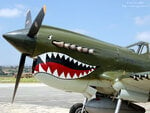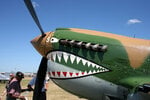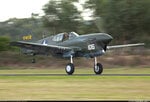The Typhoon IB of March 1943 did 417 mph (TAS) at 20,400 feet with a three blade propeller, 427 mph with a four blade propeller. Climb to 20,000 feet was 7.4 or 6.9 minutes respectively with the two propellers.
It was cleared to dive in service at 500 mph at 5,000 feet carrying two 500lb bombs. Of course it was tested in significantly faster dives at Boscombe Down.
The P-40 F is not close to this performance. According to the graphs in Dean (America's Hundred Thousand) It managed just 300 mph at sea level and 365 mph at 20,000 feet. Time to 20,000 feet was 11.5 minutes!
Cheers
Steve
Hello Stona,
Let's be fair. Those speeds are about the best results ever for the Typhoon Mk.IB.
Most of the test reports show more like 400 MPH plus or minus 5 MPH.
There are also sources that list the P-40F as hitting speeds in the low 370 MPH range.
It doesn't change the standings much but it is a bit closer than your numbers indicate.
Hello Shortround6,
I am somewhat surprised that the Merlin suffered so badly due to the location of its carb intake.
There was a plate to block off the opening and presumably draw air from a filtered source.
The closed intake can be seen in quite a few photographs.
I believe the same kind of arrangement was done on later models of Allison P-40.
As for failures, I don't put them all into the same category.
If a failure to function causes the mission to end but does not prevent a return to base, I see that as quite different from a failure that prevents a return to base.
A gun stoppage is one thing. An exploding shell that wrecks your own engine or an exploding gun that blows a hole in your wing structure is quite different.
An engine that wears out too quickly and needs an overhaul may not be so good, but it beats the heck out of one that goes quiet without warning and without enemy action.
- Ivan.



